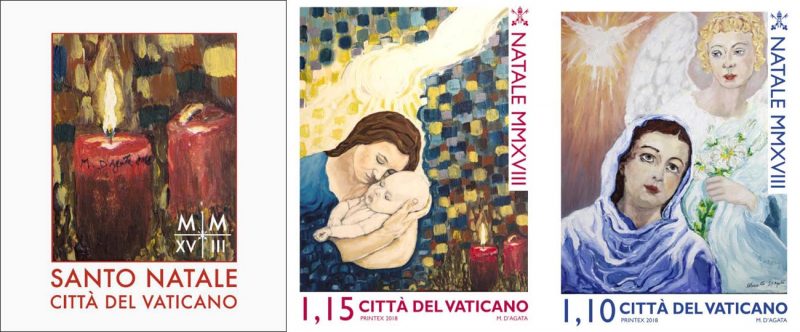
This is the cover image for the booklet containing the Vatican’s 2018 Christmas stamps (left). The images on the stamps were painted by a prisoner serving a life sentence. (CNS/courtesy Vatican Philatelic and Numismatic Office)
VATICAN CITY (CNS) — As the Christmas season draws near, the Vatican postal service prepared a unique set of commemorative stamps designed by a talented, yet unlikely, artist: a prisoner serving a life sentence.
The Vatican Philatelic and Numismatic Office announced Oct. 30 that its 2018 Christmas stamps will feature images of the Annunciation and of Mary holding baby Jesus painted by Marcello D’Agata, an inmate at Milan’s Opera prison.
A brochure for the stamps from the Vatican post office said that choosing artwork painted by a prison inmate was a response to Pope Francis’ call for compassion toward the imprisoned and for efforts to help them see that prison is not just the end of a life of crime but the beginning of a new life.
[hotblock]
In a video message to inmates at the Ezeiza federal penitentiary in Argentina Aug. 24, 2017, the pope said that punishment can be fruitful only when inmates are helped to look toward the future rather than only back at a past lived out in shame.
“Let us not forget that for punishment to be fruitful it must have a horizon of hope,” he said. “Otherwise, it remains closed in on itself and is just an instrument of torture; it isn’t fruitful.”
The pope’s video message was addressed to inmates taking part in the prison’s university studies program, which he said was one of many programs that provide “a space for work, culture, progress” and are “a sign of humanity.”
The Vatican post office took part in a similar program for burgeoning artists at the Milan prison where D’Agata honed his painting skills.
Mauro Olivieri, head of the Vatican Philatelic and Numismatic Office, said that entrusting the design of the new Christmas stamps to an inmate serving a life sentence was “a sign of hope, trust and faith in one’s neighbor and in his ability to understand the evil that was committed and to rehabilitate.”
Prisoners “are precisely the least of the least who, according to Jesus’ teaching, deserve our attention the most,” Olivieri told the Italian daily Corriere della Sera in an article Nov. 6.
D’Agata’s painting of the Annunciation feature Mary looking skyward as the Archangel Gabriel, holding a small bouquet of white lilies, gazes at her. Directly above Mary is a white dove, a symbol of the Holy Spirit, with light beams emanating from its outstretched wings.
[tower]
The second stamp depicts Mary after the Nativity, her hands holding the infant Christ and nestling the sleeping child in a maternal embrace. A single red candle near them is lit while the star of Bethlehem radiates light from above.
The bright smattering of colors that brings D’Agata’s artistic creations to life stands in stark contrast to the dark, colorless existence of a life of crime, he said.
As a child, D’Agata said, the appearance of a plain sheet of white paper was enough to stir his creativity and inspire him to draw and color images that appeared in his imagination.
“Of course, they were just scribbles, but I liked doing it very much because on those sheets, I gave shape and color to my emotions and, most of all, to my dreams,” D’Agata said in an interview published Nov. 6 in L’Osservatore Romano, the Vatican newspaper.
Now serving a life sentence for mafia-related crimes, D’Agata said he realized that “wrong choices do not pay but are paid.”
“When I arrived (in prison), I had stopped scribbling, giving color to my dreams and to the future,” he said. “For almost a quarter of a century, I was restricted to environments that prevent colors from livening up my life. That isn’t a metaphor.”
However, things changed when prison officials allowed a small group of inmates to take an art course that began after a 2013 agreement between the Italian Ministry of Justice and the Italian postal service, along with several Italian philatelic organizations.
According to Corriere della Sera, the group — comprised of 12 inmates — gathers every Monday to sketch and paint in an art studio that prison administrators created in the facility’s maximum-security wing.
Once the course began, D’Agata said, “the source of inspiration and abilities that were once dormant came back to life.”
After beginning with sketches and drawings, the Italian prisoner transitioned to painting, which he described as a new passion that spurred him into a “continuous crescendo in search of improvement, especially on a personal level.”
Painting is more than just a hobby, D’Agata said. It gave him a way to escape the confines of his prison and go to a place where his imagination was the only thing that ran wild.
“The love for art,” he said, “awakened a part of me that I did not know was there because it was hidden by that darkness that stole my life.”
PREVIOUS: Plenty of weapons, lack of safe water is a ‘disgrace,’ pope says
NEXT: Pope recognizes martyrdom of U.S. Christian Brother



Share this story